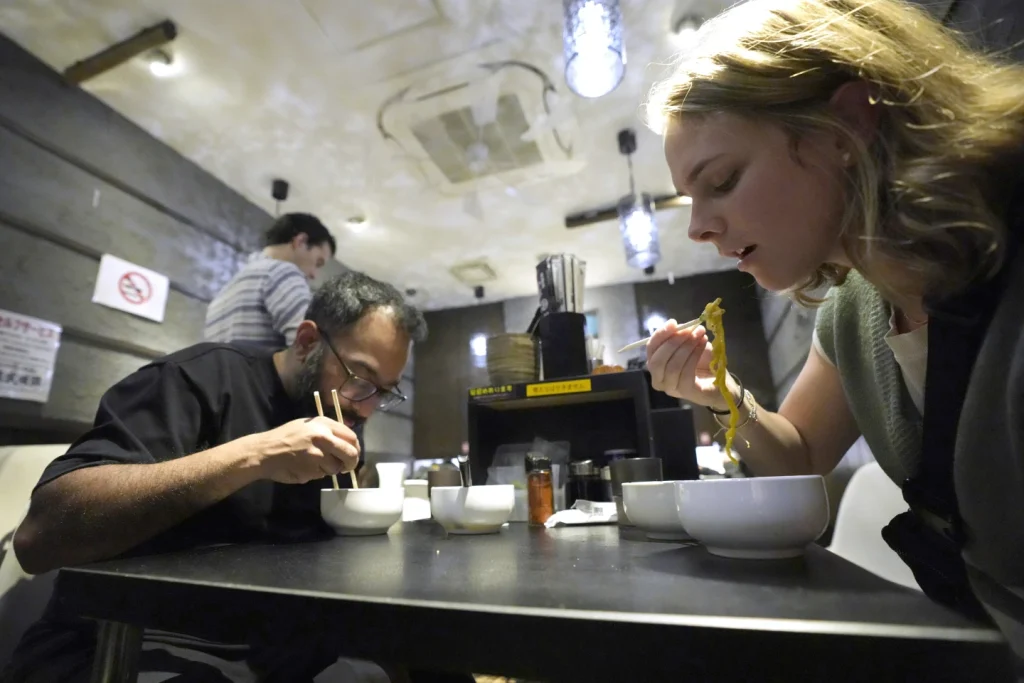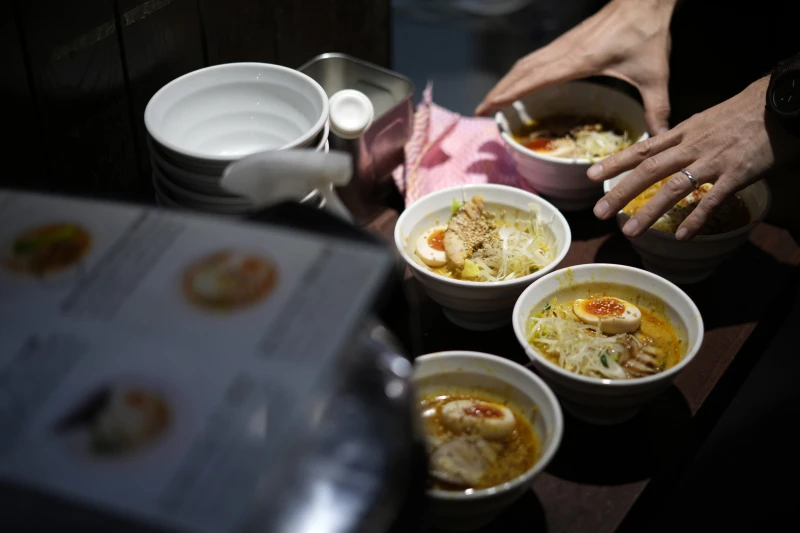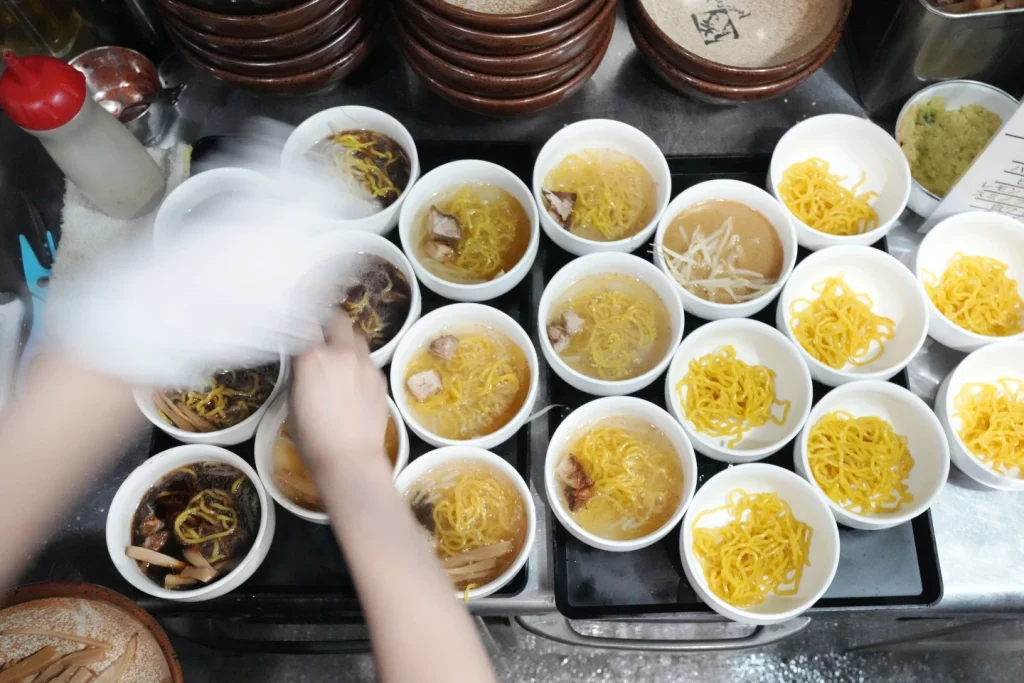Ramen, a quintessential Japanese dish, has captivated the taste buds of people worldwide with its spicy, steaming, and slurpy goodness.
The bustling streets of Tokyo bear witness to the fervor surrounding this beloved noodle soup, where long queues winding around blocks are a common sight, and waiting patiently for an hour just to savor a bowl of ramen is deemed a worthy indulgence.
Despite the humble settings of many ramen joints, the satisfaction derived from a piping hot bowl of this culinary delight seldom fails to gratify the palate.
The essence of ramen lies not only in its delectable flavors but also in the theatrical preparation that often unfolds right before the diners’ eyes, behind unassuming counters.
Priced at around 1,000 yen ($6.50) per serving, ramen comes in a myriad of variations, each boasting distinct regional flavors and culinary nuances.
Whether it’s the savory soy-based “shoyu” or the piquant miso paste, the options are as diverse as they are tantalizing. Some iterations of ramen pack a fiery punch with a generous sprinkling of chili, while others eschew the traditional broth in favor of a flavorful dipping sauce to accompany the noodles.

The hallmark of ramen lies in its signature curly noodles, which stand in stark contrast to the slender buckwheat “soba” or the thicker “udon” noodles prevalent in Japanese cuisine.
The delicate texture of ramen noodles, coupled with the rich umami-laden broth, creates a harmonious symphony of flavors that has garnered a global following.
Beyond the shores of Japan, ramen has experienced a meteoric rise in popularity, transcending cultural boundaries to become a culinary phenomenon in countries like the United States and South Korea.
Retail sales of ramen in the United States have witnessed a staggering 72% increase since 2000, as per NielsenIQ, a prominent sales tracker.
In the span of 52 weeks leading up to April 13, Americans splurged over $1.6 billion on this beloved noodle soup, underscoring its widespread appeal.
The culinary landscape has also witnessed an evolution in the realm of ramen, with restaurants across the globe offering innovative twists on the traditional dish.
Technomic, a renowned research and consulting firm in the restaurant industry, notes the emergence of unconventional ramen creations beyond the classic soup-based variants.
Notable examples include Del Taco, a popular Mexican chain, which recently introduced the tantalizing Shredded Beef Birria Ramen, showcasing the fusion of diverse culinary influences.
In conclusion, ramen stands as a culinary marvel that transcends borders, captivating the hearts and taste buds of food enthusiasts worldwide.
From the bustling streets of Tokyo to the bustling metropolises of the United States and beyond, the allure of a steaming bowl of ramen continues to enthrall gastronomes with its irresistible blend of flavors and textures.
As the global appetite for this iconic noodle soup shows no signs of waning, one thing remains certain—ramen is not merely a dish but a culinary journey that promises to delight and entice all who partake in its savory embrace.

Instant noodles, a convenient and easily cooked meal in hot water, have become a staple in many households around the world.
The invention of instant ramen by Momofuku Ando in 1958 marked a significant moment in culinary history, particularly in Japan where food scarcity was a pressing issue.
Ando’s creation of instant noodles revolutionized the way people consume and enjoy ramen, leading to the establishment of the renowned food company Nissin Foods.
However, despite the convenience and popularity of instant noodles, they cannot fully replicate the experience of dining at a traditional ramen restaurant.
The experience of enjoying a bowl of ramen at a cozy eatery is unparalleled, as described by enthusiasts who frequent ramen shops multiple times a week.
The sensory delight of savoring a steaming bowl of ramen, coupled with the unique flavors and textures, creates a memorable experience for many.
In Japan, ramen holds a special place in the hearts of its people, with each region offering its own twist on this beloved dish. From Hokkaido classics to Fukuoka fusion, the variety of ramen styles and flavors reflects the diverse culinary landscape of the country.
Ramen aficionados embark on culinary tours to explore different ramen establishments, sampling a range of flavors and learning about the rich history of this iconic dish.
Despite the challenges faced by ramen establishments, such as the impact of the pandemic and rising costs, innovative solutions have emerged to meet the evolving demands of consumers.
Home delivery services for frozen, professionally cooked ramen have gained popularity, providing a convenient option for ramen lovers to enjoy their favorite dish at home.
Additionally, collaborations between top ramen joints and food companies have led to the creation of packaged ramen kits, allowing enthusiasts to recreate the restaurant experience in their own kitchens.
The appeal of ramen lies in its complexity and depth of flavors, which are difficult to replicate at home. The intricate process of preparing ramen broth, using a combination of meats, fish, and spices, requires time and skill to achieve the perfect balance of flavors.
From rich pork-based broths to light and fragrant seafood stocks, each bowl of ramen tells a story of culinary craftsmanship and tradition.

The versatility of ramen extends beyond its soup base, with a myriad of toppings and flavor enhancements available to customize each bowl.
From traditional toppings like barbecued pork and boiled eggs to more adventurous choices like coffee-infused broth and ice cream garnishes, ramen offers endless possibilities for culinary exploration.
Whether enjoyed as a comforting meal on a cold winter day or as a social gathering with friends, ramen continues to captivate food enthusiasts around the world.
In conclusion, ramen is not just a dish; it is a cultural phenomenon that embodies the essence of Japanese cuisine and hospitality.
As the popularity of ramen continues to grow globally, its enduring appeal lies in its ability to bring people together, evoke nostalgic memories, and inspire culinary creativity.
Whether enjoyed in a bustling ramen shop in Tokyo or prepared at home with a packaged kit, the experience of savoring a bowl of ramen transcends mere sustenance—it is a celebration of taste, tradition, and community.
